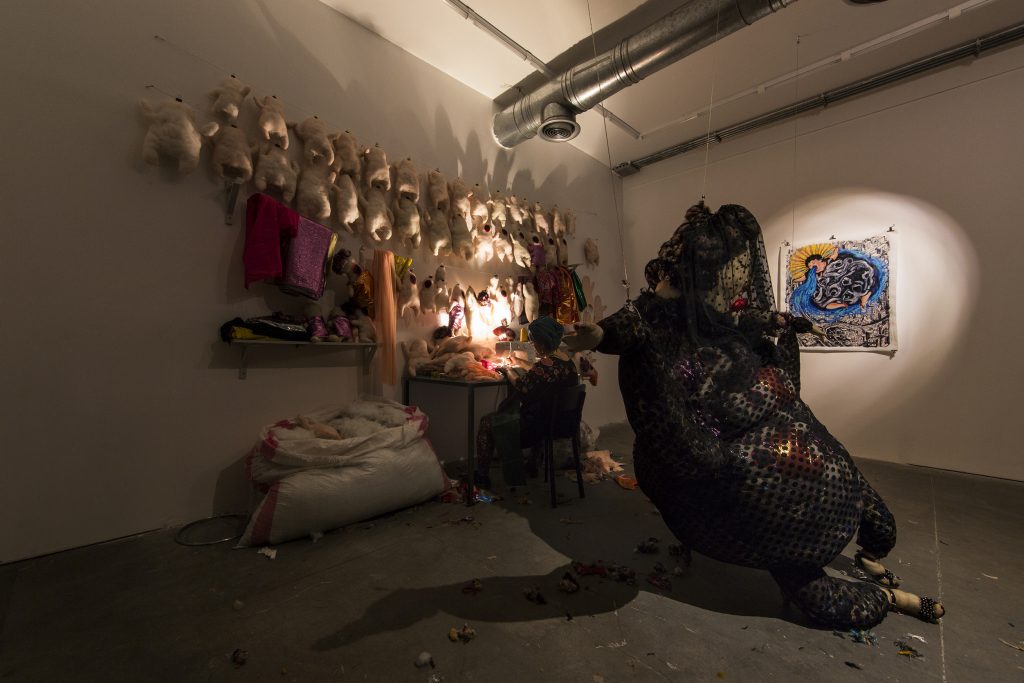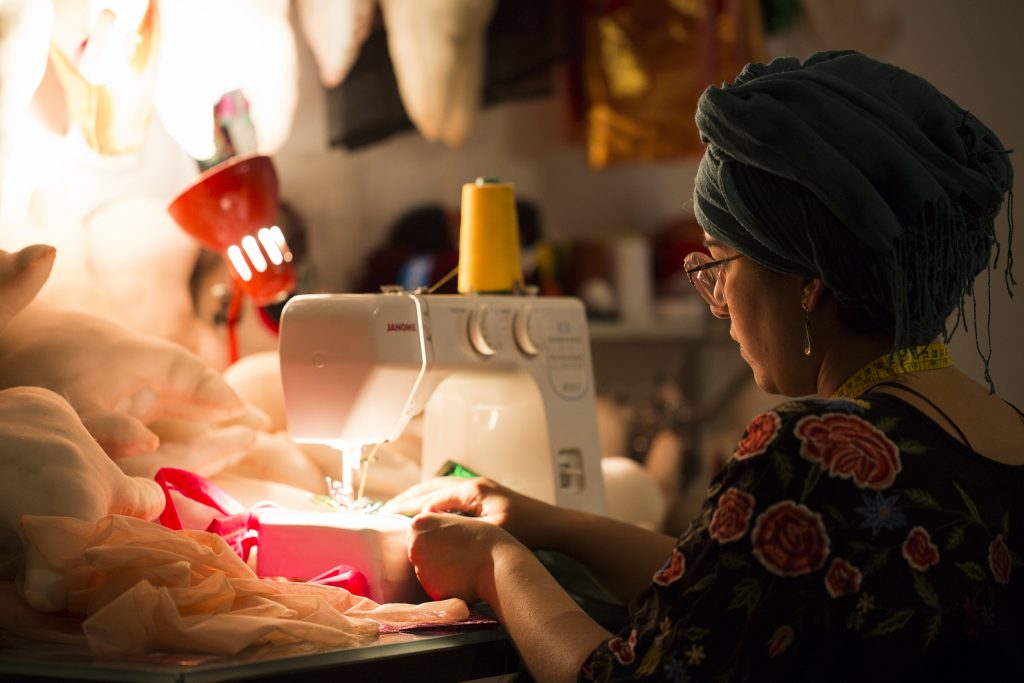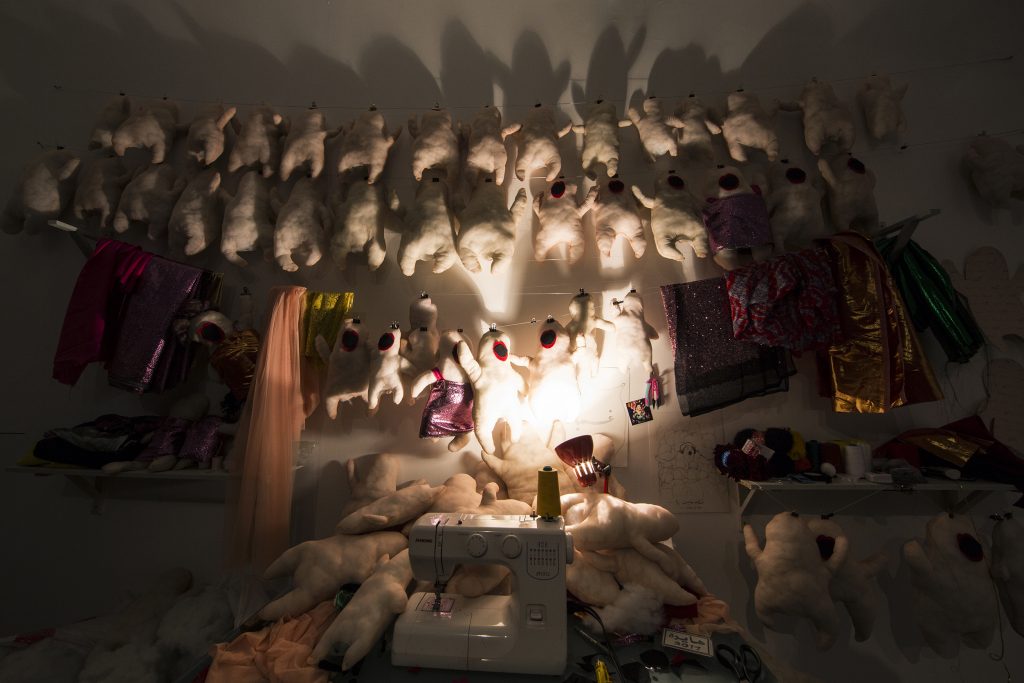Golrokh Nafisi
Performance/Installation
Dastan Gallery
Tehran Oct 2017
Assistant and researcher : Ahmadali Kadivar
Sorrow-Breeze (Ghambaad) is a project based on the life of a popular female Iranian singer named Hayedeh from the 1950s who was banned from singing after the 1979 Iranian Revolution. Despite this, her voice resounds in Iranian urban culture, and maintains an omnipresence until now. Ghambaad was a 5 day long live performance at Dastan Gallery, which is located in the center of Tehran between two major art universities. During the five days, many people visited the gallery. As they listened to the show, they participated in the process of making small dolls, representations of Hayedeh, which were collected together into a single large statue of Hayedeh. In the final day of the show the small dolls were distributed to the audience of the show, and thus these dolls – and Hayedeh – were able to continue their lives as a popular singer in each corner of the city. video
The “Ghambaad” project was also related to the beliefs of Iran’s substantial African-descendent community, which lives mostly in the south of Iran. Among Afro-Iranians there is a strong belief in wind (“baad”) as a life-giving force, one that empowers individuals and that must be released through song, and which travels across time and space. Through my project, I connected Hayedeh’s career as a singer and her role in the lives of Iranians to this belief in wind. For this reason, In November 2017 I took the same work to southern Iran, to the Persian Gulf coast, where there is a large community of the descendants of African immigrants who came to Iran historically. The performance took place in a contemporary art gallery of Bandar Abbas. Bandar Abbas is a port that connects the Persian Gulf, Arab countries, and Iran.
Statement:
“The coastal people of southern Iran, think of spirits and Jinns as wind and believe that that each wind carries a Jinn with it that goes into the body of human beings and possess them, making them ‘Havâi’ (lit. windy). They call the dangerous, evil and hurtful Jinn-Winds ‘Mazer’râti’ (harmful). The ‘Havâ’ (wind) people believe that ones possessed by the wind lose their control and become ill with ‘Deev-Bâd’ (lit. demon wind), that is madness and insanity, turning into a vehicle for the wind. The Havâ people call them ‘Havâi’.”
from “Ah’le Havâ” (Havâ People), published in 1966, by Gholamhossein Sa’edi (1936-1985)
To Ma’soumeh Dadehbala and her body, copied over
One — ‘Ghâmbâd’ is an term in Persian describing the inability to express our sorrow. A pain swelling in our body and throat, forcing silence. Based on a belief, Ghâmbâd is not limited to a mental state and goes beyond to possess one’s body: the swelling fo the body, or even an increase in body fat until one cannot move, and eventually death.
Ghâmbâds sometime become collective —when a society is formed and a dream possesses not only the minds but also the bodies of the people. The dream, not ever realizing, leaves out a collective swelling in the left-out bodies: historical Ghâmbâds.
Two — Popular art, interacting with a larger population, frequently becomes something beyond what its creators intended. Wandering around the streets, the bazar, and people’s homes, it transforms into a collective and shared dream, and at different times, collective happiness or sorrow add or reduces from it.
The popularity of a singer’s songs, sometimes creates an all-present phantom of them, makes their body larger and casts it like a shadow on public conditions. This presence and the grow of the singer’s phantom, simultaneously creates an empty body of them which will be filled by the ones repeating their songs: a multiplied body, a body of everyone’s.
Sad popular songs are also our collective catharsis —catharsis as an ending to fear, and a means towards more pity.
The expression of sadness, especially when expressed through “us”, makes it possible to pass the state of a collective Ghâmbâd by emptying ourselves of the sadness.
Three — Leila Kasra (1939 – 1989), also known by her pen-name, “Hediyeh”, was a songwriter who wrote the lyrics of over 60 songs for a number of pop singers. Eleven years of her 50-year-long life was spent fighting cancer. In one of her last interviews before her death, she talks about songs that she wrote before and after seventeen operations, in the ambulance or on the hospital bed. The direct expression of toil, and complaining of the ‘time’ (the unconquerable and ever-present factor that possess our lives) and an invitation to a collective madness, not thinking of tomorrow and living in a sensational present, are the main themes in her songs; all of which Hayedeh, one of the most prominent singers who performed Hediyeh’s songs, is known for.
“Heavens, your lightning is nulled, you cannot disembody me, I will live on by my songs.”
Four — “All of us, charged with intoxication, are chastised by the whip of admonition”
Ma’soumeh Dadehbala continues her urban life somewhere above us. Her voice is heard through the stereos of taxis in the scary traffic jams or windows of homes in quiet neighborhoods. Almost anyone knowing Farsi has heard her voice. It sometimes appears in the bodies presenter and often times as a means to fight personal Ghâmbâds, as a way to collectively mourn against the same sorrows.
Five — The gallery is a studio.To show a body which is present all around, one is inspired by the thrill of repeating and murmuring whatever has been made before us and is repeated by us.
Golrokh Nafisi
Oct 2018



